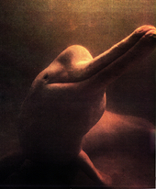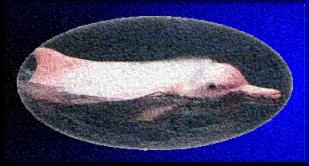|
|
|
|
|
Pink DolphinBack to the main species page  
Many of the great rivers of the world have dolphins in their waters. The Gangies of India, the Yank see river in China, even the Mississippi of North America is once said to have had a dolphin before pollution from the Industrial age killed it off. Sadly, all the dolphin species of great river system around the world are in danger of extinction for the same reasons. By far the mightiest of the great rivers is the Amazon. It stretches across 6000 km of the South America continent touching nine countries. Its many tributaries are so vast they themselves rival the other great river systems of the world. Within the deep river channels and inland lakes of Amazonia, pink dolphins, called Boutu by the local fishermen, swim in small groups, feeding on a variety of fish and soft crabs. Described by Jacques Cousteau during an expedition in the mid 1970's, these, the largest of all river dolphins, are characterised by their pink colouring. During the wet season when the entire Amazon basin floods by as much as 30ft, the Boutu leave the safety of the main river channel and forage for food amongst the submerged forest. It has a highly developed echolocation system and navigates though the silty flooded planes avoiding submerged vines and trees. During the many weeks of flooding the Boutu has been known to travel across hundreds of kilometres of the Amazon basin and appear in major tributaries, such as the Orinnoco in the far north. Unlike other dolphin species the Boutu have very flexible bodies and widely spaced vertebrae. Instead of a dorsal fin there is a low ridge along its back, it is not known how this ridge benefits its motion. Boutus have a significant place in the folklore of many different tribes within Amazonia. The Ticunas people believe that they are magical beings; once human. They respect the Boutu and have a strict taboo on hunting them. Legends from other tribes suggest the Boutus are the harbringers of both good and evil. They are said to gate crash riverbank parties in the form of people, enticing maidens back to their underwater cities where they wear stingrays for hats and snakes for belts. Women who go swimming while menstruating are said to be made pregnant by the Boutus. The offspring of these women are believed to be magicaly gifted and often become the tribes shaman. It is because of these legends and traditions that the pink dolphin may have its chance to survive into the next century. Yet, as the Amazon territory is carved up and exploited, these stories have loose their importance. Now pink dolphins are hunted for their eyes, teeth and genitals, all because of supposed aphrodisiac powers. and the increase of tourism (ecotourism). The influx of people into the Amazon is having a profound effect on the Boutu. Increased commercial fishing with nylon nets where they drown "accidentally". Nets left by careless fishermen are traps which claim many dolphin lives each year. Pollution from urban and industrial waste, farm chemicals and deforestation have also become a huge threat. River traffic transporting toxic chemicals and oil has increased the risk of devastating spills. Large quantities of mercury are used in the extraction of gold from open cut mining operations which are prolific throughout Amazonia. The effects of heavy metal pollution such as mercury devistates all levels of the food chain consequently the Boutu, a large mammal at the top of food chain, is in serious danger. Few restrictions are placed on pollution controls in the Amazonian frontier have been with little enforcement by the governments. Why is the pink dolphin pink ?Not a lot is known about the dolphin's colouring because of their remoteness and rarity. It has been speculated they are pink for the same reason as pink flamingos. Like the dolphin, these marshland birds are not born pink but turn this colour as they get older. The flamingos are coloured by a red pigment found in the muscle tissue of the crabs and shellfish they eat. The coloured molecule is not digested, yet is still absorbed in the birds gizzard and accumulates in the shafts of the birds' growing feathers. Although this pigment is not visible in the raw meat of crustatia, it is the same pigment which causes a prawn to turn pink when cooked. Often flamingos in captivity are fed shellfish rich in this pigment in order to brighten their colourful appearance and highten their appeal. Because the pink dolphin also feeds on these animals in the marsh lands and flooded planes of the Amazon basin it is thought the same pigment accumulates in its skin as it gets older.
However, another plausible theory exists as to why this dolphin develops the colouring.
Like most dolphins, Boutus are born a dark gray. Yet they loose this colour as they become older.
It is thought that the pink colouring is simply a flush of blood moving through the
dolphins skin, much the same way a human blushes or pinkens during exercise. The pink dolphin
lives exclusively in warm tropical waters and does not need this thick layer of white fat common
to other ocean dolphins. In contrast the Beluga whale of the St. Lawrence River in northern Canada,
remains white because of the thick layer of blubber needed for insulation.
Please dont forget to sign my guestbook as I love getting mail.Sign my Dreambook! |